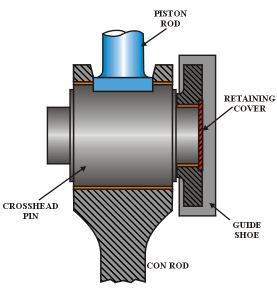Describe how top end bearings and slippers are supplied with lubricating oil.
State what factors govern load bearing capacity of top end bearings.
a.

The sketch shows a partial section through the crosshead on a modern large slow speed engine.
The piston rod is bolted to the crosshead pin which reciprocates in the crankcase. The connecting rod swings about the crosshead pin and transfers the downward thrust to the crankshaft converting it to rotary motion. The side thrust is transferred into the engine by the guide shoes which reciprocate in the crosshead guides which are bolted to the A frames
The top end of the connecting rod is forged to form the housing for the continuous bearing. This combined with a large pin diameter gives the maximum surface area thus reducing the loading on the bearing to a minimum.
The top half of the bearing is located in a bearing cap which incorporates a slot to allow the piston rod foot to be bolted to the top of the crosshead pin.
The large diameter finely finished hardened pin is reduced at each end to form journals on which the guide shoes are located. The guide shoes which run in the crosshead guides are free to rotate a limited amount to allow for slight misalignment. To allow this rotation, the locating bores of the guide shoes are lined with a white metal bearing. A retaining cover holds the shoe in place on the journal.
b.
Oil is supplied to the crosshead via a telescopic (MAN B&W) or a swinging arm link (Sulzer). The oil supplies the crosshead bearing, the guide slippers, oil for piston cooling and bottom end bearing. On the sulzer engine, the oil is boosted in pressure to about 12bar.
c.
The crosshead on a slow speed 2 stroke is a difficult bearing to lubricate effectively. The load is continually downward and because the con rod swings about the pin, changing direction each stroke, true hydrodynamic lubrication cannot take place. Instead the lubrication starts as boundary, and as the rubbing speed increases, a hydrodynamic film is built up. As the rubbing speed decreases the lubrication becomes boundary once again.
Modern top end or crosshead bearings are of a tin aluminium alloy which has a higher load bearing capacity than a tin antimony babbit metal. To increase the load bearing capacity, the pin diameter is as large as possible to increase the rubbing speed, and the continuous lower bearing increases the bearing area over that of the older forked type crosshead.
This comment has been removed by the author.
ReplyDeleteSir,thanks for the explanation. I have some doubt regarding the Lubrication(MAN B&W).From cross head the lube oil passes to the piston and the crank pin bearing for cooling. What will be the lube oil pressure in piston, Xhead and crank pin bearing. Will it be same? or if it is different how does that happens? Please clarify my doubt...
ReplyDelete16 bar
DeleteSulzer 12.5 Bar as they use plain bearings and have to overcome the force to get the oil in. MAN BNW 2.5 Bar as they have grooves in the loaded half and do not use booster pumps like Sulzer.
ReplyDeletesir can u explain little more clear crosshead lubrication
ReplyDeletesir can u explain little more clear crosshead lubrication in man b&w engine
ReplyDeleteIn manb&w oil from crosshead goes to crankpin or oil from crankpin goes to crosshead
ReplyDeleteWhat kind of high pressure pump used for crosshead lubrication)
ReplyDeleteA large screw type pump is employed for boosting the pressure upto 14 bars. It takes suction from the main lub. oil line and discharges to the crosshead lub oil line.
ReplyDelete